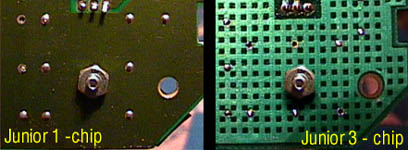FAQ's
![]()
Yup, it's me, Ben, and I'm here to answer some of your most Frequently Asked Questions. So here goes!
Q: Can I buy one? / If I send you parts will you make me one?
A: There is a good chance of it. For the most up-to-date info, please check the NEWS section of my site.
Q: How did you make the case?
A: The case was made in 2 halves, front and back. Each half was made from a 1-inch thick piece of Acrylic. The acrylic was 'carved' into shape by a computerized router. Check the INFO HUB section for more info! (info hubs are always filled with info, I hear)
Q: I thought an Atari ran off wall power? How does it run off batteries now?
A: The power adapter thing for an Atari (or most systems before 1995) actually takes a 120 volts AC current and knocks it down to 9 volts DC before it goes into the Atari. Therefore, if you just stick 9 volts current into the Atari, it'll work the same way. Check my How To and 2600 VCSp story sections for more info.
Q: I want to portable-lize my NES or SNES. Is that possible?
A: Sure. I know a NES will run off a 9 volt battery, and the SNES probably does to. (I've never tried, though). A good thing is try is using even LESS power, like 5 or 7 volts, because sometimes that's all you need! (even though the power input if 9 volts). Just never try using MORE power and make sure the polarity is correct or ZAP! Check the How To section for more info.
Q: Will you do a 7800 portable?
A: Have you ever seen inside one? I didn't count, but it must have at least 8 chips in it, and they are BIG! The board is quite complex, as well. On top of that, the 7800 wasn't really that popular and not a whole lot of games came out for it. So I can't justify doing it, in my mind. I have also toyed with the idea of an 800XL laptop, but, nah! Although that would be really cool...
Q: What do you do for a living? Where do you get all this free time?
A: I am a graphic artist at a sign company in Richland Center, WI. www.signface.com. This job gave me skills that came in very handy when I wanted to make the Atari 2600 VCSp a work of art. And as for free-time, well, isn't Atari worth it?
Q: How did you do the text / graphics / logos / color bands on the thing?
A: We have a couple thermal transfer printers at work and they print images, text, or anything else onto vinyl material, which can then be applied to whatever you wish (except trees). The vinyl I used for the Atari was clear, therefore, the text shows and lets the background show through. (that's how the metal band with the color stripe was done)
Q: Have you thought about using an EPROM to download games off a computer?
A: Yes, I have, and there are some people that have constructed such a device for an Atari. Here is their site: http://www.retrocomputing.org/. It might be possible to incorporate one of these devices into an Atari portable, although size might be a factor. It's definitely something I'm thinking about. Although I have to admit I like having the original cartridges, since I'm a purist.
Q: Have you thought about using an Atari 2600 Junior for your next project?
A: You
bet your copy of Chase the Chuckwagon! I had an Atari 2600 Junior with the 'one-chip' design, however, I seem to
have fried it. (oops!) It was neat, they combined the 3 Atari 2600 chips
(Stella, Riot and CPU) into one chip. These were the model 2600 Juniors made
in 1987, the serial number on mine is "A1 92 1977823".
I have a couple 2600 Junior's
with the 3 chip circuit board that were made in 1983, but these aren't the
kind I want to use. They have 3 big chips, and a messy circuit board. They
look gross inside, whereas the one-chip model has a nice circuit board design.
If anyone has an idea of where I can get more one-chip 1987 model
Atari 2600 Juniors, please email me!
Thanks!
Note: I have received some emails from people wondering how to tell the 1-chip from the 3-chip without opening it. Here's how:
Flip the unit over. On the lower-right hand side, you should see some vent-holes. Look through this vent...

This is actually the heat sink area around the power regulator. If you see the smooth board like the left picture, it's an Atari Junior 1-chip. If it looks more green, more messy, and more OLD like the right picture, it's a 3-chip.
Hope this clears things up!
![]()
Well, those were my most Frequently Asked Questions. There is more technical info in the How To and Info Hub sections of my site. If you have questions that I haven't addressed (like my favorite food or things like that) feel free to email me and ask away! Really good questions will probably get put in this section for the whole world to see!
-Ben